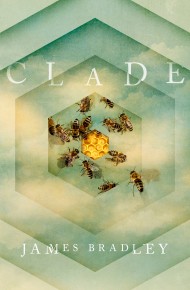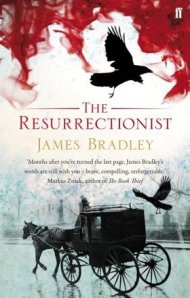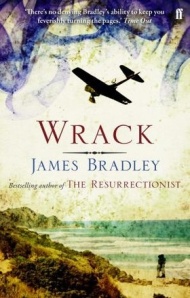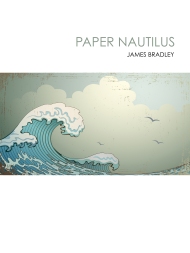Bloody Beauties: The Rise and Rise of Vampire Lit
 Right now, as you read this, someone you know is probably reading Twilight. That’s not a guess, it’s almost a statistical certainty: with more than 42 million copies sold, Stephenie Meyer’s vampire novel has left behind bestsellerdom and entered the stratospheric realm of full-blown cultural phenomenon, that gilded domain formerly inhabited by Dan Brown and JK Rowling. Indeed, over the first three months of 2009, Twilight and its three sequels accounted for one in 20 of all books sold in Australia.
Right now, as you read this, someone you know is probably reading Twilight. That’s not a guess, it’s almost a statistical certainty: with more than 42 million copies sold, Stephenie Meyer’s vampire novel has left behind bestsellerdom and entered the stratospheric realm of full-blown cultural phenomenon, that gilded domain formerly inhabited by Dan Brown and JK Rowling. Indeed, over the first three months of 2009, Twilight and its three sequels accounted for one in 20 of all books sold in Australia.
Of course if you are over 25, or don’t spend much time with teenage girls, it’s a phenomenon that may have passed you by, though it’s unlikely you’ve missed the movie poster, featuring a doe-eyed James Dean (or is that Luke Perry?) lookalike (Robert Pattinson) protectively and oh-so-sensitively cradling a palely overripe teenage girl (Kristen Stewart).
The basic premise of the novels is simple. Seventeen-year-old Bella leaves her mother in sunny Phoenix to stay with her father, the sheriff of the dank, dark but insanely beautiful town of Forks, deep in the primeval forests of Washington State. In Forks, Bella meets Edward, one of a “family” of beautiful but stand-offish foster children who live out in the woods with their “father”, the local doctor. Edward is the emo age’s idea of the perfect Byronic hero: impossibly handsome, talented and soulful, but with one niggling problem. He’s a vampire.
As personality defects go, it’s not the worst there could be, not least because Edward is, in a sensitive new age guy kind of way, a “good” vampire, one of a small number who have given up hunting humans in favour of animals. And pretty soon, unsurprisingly, he and Bella are deeply and passionately in love, a scenario that brings its own complications, since Edward’s unnatural desires are so strong he can barely touch Bella without wanting to drink her blood.
Even the uninitiated may now be beginning to grasp the appeal of the books, especially to teenage girls. There’s something so deliciously trashy about the whole set-up, with its combination of true love, hopeless longing and – once the evil vampires hit town – general mayhem, that it’s odd someone didn’t think of it before (though of course they did, but that’s another story).
In isolation, the success of Twilight and its sequels, New Moon, Eclipse and Breaking Dawn, might seem like a fluke, one of those peculiar pop cultural bubbles that form from time to time. But in fact vampires are everywhere. On television True Blood has become HBO’s most popular series since Sex and the City and The Sopranos, and there is a horde of new vampire shows in development. On the big screen the Underworld series, featuring the porcelain-skinned Kate Beckinsale and the seemingly shameless Bill Nighy, vies with Lesbian Vampire Killers and the more up-market chills of Let the Right One In, Tomas Alfredson’s film adaptation of John Ajvide Lindqvist’s novel. And in their bedrooms teenagers are deep in the pages of Vampire Academy, The Vampire Diaries, Anita Blake: Vampire Hunter or any one of a legion of Twilight imitators.
It’s tempting, faced with this wall of fangs, to ask why now? But I suspect that’s the wrong question, because it implies there was a time when popular culture wasn’t seething with the undead. Looking back it’s difficult to see when that moment was. Instead, it might pay to ask a slightly different question, about what it is that makes the vampire myth so enduring. Why do we keep coming back to it, what gives it its power to unsettle and delight? And what are we to make of this rash of 21st century vampires? Are they simply Dracula updated, or are they something different, and new? And, perhaps most urgently, what do the present crop of vampires tell us about ourselves?
It is traditional, when discussing the origins of the vampire myth, to point to the manner in which beliefs with vampiric elements seem to recur throughout history. In 1928, the monumentally bizarre Montague Summers, whose lifelong interest in the occult, questionable ordainment as a Catholic priest and sometime friendship with British warlock Aleister Crowley, might have made him a suitable model for Dracula’s Van Helsing had Bram Stoker not already invented him, wrote in The Vampire, His Kith and Kin:
Assyria knew the vampire long ago, and he lurked amid the primeval forests of Mexico before Cortes came. He is feared by the Chinese, by the Indian, and the Malay alike; whilst Arabian story tells us again and again of the ghouls who haunt ill-omened sepulchres and lonely cross-ways to attack and devour the unhappy traveller. The tradition is world wide and of dateless antiquity.
Similarly, in his 2008 book, From Demons to Dracula: The Creation of the Modern Vampire Myth, Matthew Beresford declares:
In the modern West the vampire takes the form of a somewhat aristocratic and seductive male, complete with cape and fangs, and with the ability to transform himself into a bat. This picture is, though, just a partial story; a reflection of the Victorian imagination … To dissect this image is to uncover the real horror of the vampire, an evil that has tortured the human imagination for thousands of years.
In a way it should not be surprising that beliefs about vampires and vampire-like creatures are so widespread. The vampire is a creature of unsettling and archetypal power. Dead yet alive, like yet unlike, human yet not, its very nature disturbs the basic categories with which we order our world and speaks to our most deep-seated anxieties about death, the body and the passage out of this world into the next.
Yet as Ken Gelder points out in his 1993 study, Reading the Vampire, the tendency to emphasise the multiple origins of the vampire myth has obscured the truth. The creature we understand as the vampire – aristocratic, befanged, undead, able to pass its curse on through its bite – is a Romantic creation, but its origins lie in southeastern Europe and the folk beliefs not just of the vampire’s traditional home in Transylvania (Romania) but also Hungary, the former Yugoslavia, Moldavia, Bulgaria and, importantly, Greece. For it is there that stories of the living dead merged with the Christian belief in the sacrament and the physical resurrection of the body to create something new and striking. And it is there the myth took on many contemporary elements: the vampire’s susceptibility to garlic and running water, the need for vampires to be invited before they may enter the home and, perhaps most crucially, the belief that a vampire may only be killed by beheading or by driving a stake into its heart.
Despite serving as the origin of the myth, some of these folk beliefs bear little resemblance to our idea of the vampire. Many were ruddy-faced, or bloated with blood, while others were mischievous spirits, closer perhaps to fairies than Anne Rice’s LeStat. Nor were they even necessarily human: Beresford recounts a Kosovar Gypsy tale about the propensity of pumpkins and watermelons to become vampires if left unattended for 10 days (“The gathered pumpkins stir all by themselves and make a sound like “brrl, brrl, brrl!’ and begin to shake themselves … sometimes a trace of blood can [also] be seen on the pumpkin”).
But the contemporary idea of the vampire begins in the 18th century, with the intrusion of vampiric themes into European and later English literature. Inspired in part by the exhumations of two Serbian men, Peter Plogowitz and Arnold Paole, both of whom were supposed to have risen from the grave, and a rash of studies and articles on the subject, authors as various as Heinrich August Ossenfelder, Gottfried August Burger and Goethe produced poems and ballads such as The Vampire (1748), Lenore (1773) and The Bride of Corinth (1797).
But if the modern notion of the vampire springs from any one source it is John William Polidori’s The Vampyre. Published in 1819, based in part upon a story told to Polidori, who was Byron’s physician, by his superstar patient, The Vampyre quickly became a sensation, spawning a host of imitators, unauthorised sequels and even stage shows.
For Polidori success was bittersweet and brief. In an attempt to capitalise on Byron’s fame, his publisher John Murray published The Vampyre under the poet’s name, a move Byron and Polidori protested against. Nor, despite its success, did it bring Polidori riches. Scarcely more than two years after its publication the 25-year-old, weighed down by debts, drink and depression, died, most likely by his own hand.
In its passage through the Romantics to Polidori, the vampire myth was altered, taking on a more overtly sexual quality, which is even more evident in works such as J.Sheridan LeFanu’s Carmilla (1872). But The Vampyre also introduces what Beresford describes as “the Ruthven formula”, reimagining the vampire not as something bloated and deathly, but as an aristocratic and corrupting figure, by turns alluring and deadly.
There is little doubt Byron served as the model for Polidori’s Lord Ruthven. Certainly the name was appropriated from the villain in Glenarvon, Caroline Lamb’s scandalous fictionalised account of her affair with Byron.
There is something irresistible about the notion of Byron as the model for every vampire from Dracula to LeStat and beyond. But there can be little doubt that in developing his Ruthven formula, Polidori grafted the vampire myth on newer anxieties about the corruption of the ancien regime and its undue influence and sexual rapacity, a hybridisation that still bears fruit. Not for nothing is True Blood’s Bill Compton a former Confederate soldier.
Yet it was Stoker who took brought these elements together into the still dazzling Dracula. First published in 1897, it is an almost impossibly fertile convergence of fin-de-siecle anxieties about sex and death and race with the lurid possibilities of the vampire myth, married to a narrative that uses the Victorian reverence for science to transform the vampire from a creature of myth into something more substantial, all wound together in a work that in its very structure anticipates the 20th century’s suspicion of single truths by providing not a single narrative but a patchwork of voices.
There is much that is lurid, even clumsy, in Dracula. For all the power of the opening sections detailing Harker’s journey to Transylvania and his discovery of Count Dracula’s true nature, it falters in the middle. Yet it is a book that, even today, pulsates with a thrillingly unhealthy energy. No-one who has read it is likely to forget scenes such as Harker’s first glimpse of the count skittering across the wall of the castle; the coach ride to the castle (given exhilarating life in Nosferatu, FW Murnau’s unauthorised film adaptation); or the intensely sexual scenes of Mina’s subjection to the count. Nor is its capacity to terrify exaggerated: save for Henry James’s The Turn of the Screw, few books can provoke such powerful reactions of fear and excitement.
Nor should its sophistication as a literary artefact be underestimated. Stoker’s use of multiple perspectives and his interweaving of technological innovations such as phonographs, phrenology and blood transfusions with the traditional, folkloric aspects of the vampire myth and its later Romantic elaborations, ushers the vampire out of the realm of superstition and into uneasy, unstable, yet unsettlingly objective reality, making its terrors manifest in new ways.
In some deep sense Dracula is the moment in which the vampire realises its ultimate potential, creating a creature and a work of such implicative power that it is almost a universal signifier, capable of containing and giving shape to almost any fear, from 19th-century worries about sex, race and miscegenation, to anxieties about homosexuality, disease and the increasingly inhuman, internationalised forces of capital.
Yet Dracula’s success, or at least the success of its many film incarnations, also carried the seeds of its demise. Max Scheck’s Count Orlock or Bela Lugosi’s Dracula may once have been terrifying, but gradually, inevitably, the grinding literality of film reduced the vampire to a parody of its former self, cackling maniacally as the Count on Sesame Street or fellating his way through porn flicks such as Gayracula (1983). Indeed, as Beresford rather baldly puts it, after millennia haunted by its shadow, “we no longer fear the vampire”.
It would be possible to argue Beresford is mistaken, and that the contemporary vampire is, in some real sense, merely an updated version of Dracula, or Lord Ruthven.
If nothing else the shape of many contemporary vampire narratives echoes those of their predecessors, almost inevitably depending on a process of gradual discovery that other forces exist in the world, ones hinted at in folklore, and ancient texts, but now forgotten. Sometimes this process is given ironic dimension, as in the film Fright Night or Stephen King’s novel The Stand, in which the heroes are equipped to battle their adversaries not by their knowledge of folklore but by their mastery of vampiric pop culture. But more often the story is presented fairly conventionally. Not for nothing does Bella in Twilight seek out a book detailing the history of Forks.
The unhealthy, unsettling sexual charge of the vampire also persists, not least in novels such as the profoundly disquieting Let the Right One In, which depicts the relationship between a troubled 12-year-old boy and a child-vampire named Eli, using the vampire as a metaphor to explore troubling questions about sexuality and pedophilia. Likewise vampirism allows Milissa Deitz’s 1999 novel Bloodlust to approach the subject of sexual obsession in fresh and unsettling ways.
And perhaps most strikingly, Christos Tsiolkas’s 2005 novel Dead Europe invokes not just the anti-Semitism at play in Dracula but also Italian critic Franco Moretti’s Marxist reading, which strips away the aristocratic trappings and casts Dracula as the solitary, despotic monopolist, recalling Marx’s description of capital as “Dead labour which, vampire-like, lives only by sucking living labour, and lives the more, the more labour it sucks.” Likewise Tsiolkas’s novel makes powerful use of the vampire myth’s perverted echoes of the Christian rite of the sacrament. In what is one of its most intense and disturbing scenes, the celebrations of a village in occupied Yugoslavia take on a frenzied edge, blood and wine and sex and death seeming to mingle into one wild cry of terrifying, exhilarating violence and release.
There is no question Dead Europe is one of the most striking and powerful novels published in this country in many years. Yet it also unwittingly proves Beresford’s point. For despite its frenzied energy even it cannot quite survive the moment in which its vampiric elements cease to be metaphorical and enter the realm of the literal.
In fact the difference lies in a reimagining of the vampire. Unlike the vampire literature of the 19th century, in which the vampire was a creature of pure, implacable evil, the vampires of contemporary narratives have a revisionist quality, their unlife imagined as a curse that torments them.
This notion of the vampire as a tragic figure finds its first expression in Anne Rice’s 1973 novel, Interview with a Vampire, and its brooding vampire hero, LeStat (played, improbably, by Tom Cruise in Neil Jordan’s 1994 film version). Rice made innovations in that book, sweeping away much of the creaking paraphernalia that 70 years of film had made so ludicrous (“‘Oh the rumour about crosses!’ LeStat laughs early on, ‘sheer nonsense’.”). This notion of the vampire as a tragic figure disrupts the easy opposition of human and vampire, self and other, asking that we sympathise with the vampire, see him not as a monster, but as a fellow being.
This process sets up new and often troubling possibilities. In Let the Right One In, Eli is, in a literal sense, a monster. She corrupts and kills, refiguring her child’s body to hunt. Yet she is also a victim, as are all those who are infected by the parasite that has transformed her, forced to trade her sexuality for protection, repulsed by what she has become. Yet the novel goes further, complicating this already troubling image of the vampire as abused child by suggesting that Eli’s relationship with Oskar, the boy she befriends, is infecting him, if not literally, then metaphorically, by distorting his sexual development to ensure he too will become a child abuser.
Yet for the most part the vampire story’s possibilities are explored in contexts that seem, at least ostensibly, more benign. Twilight’s Edward and True Blood’s Bill Compton each have relationships with humans, battling their own natures and their fellow vampires for love, as does Angel in the TV series Buffy the Vampire Slayer. (I wouldn’t be the first to see echoes of Buffy’s romance with Angel in the relationship between Edward and Bella, nor to note the debt Twilight owes to Charlaine Harris’s Sookie Stackhouse novels, on which True Blood is based.)
Conceived of in such terms the vampire seems more akin to the latter-day view of the superhero as a tragic figure struggling with the burden of their powers and beset by human frailty, such as Bruce Banner or Wolverine. Certainly it is not difficult to see something of the same adolescent desire to be not just different, but special, that underpins the allure of the superhero in the identification with the vampire that occurs in many Gothic subcultures.
Yet while the fascistic quality of the superhero is for the most part kept in check by their human connections, and by the demand they do good, vampires are not bound by the same rules. Instead they offer an image of power exhilarating in its lack of restraint. They are creatures of their natures, whatever their torments, unchecked by human morality.
This is thrilling. Yet it is thrilling, as Meyer’s construction of Edward and his siblings as the coolest kids in school suggests, not because we are afraid of vampires as we once were, but because we want, like Twilight’s Bella, or True Blood’s Sookie, to be vampires.
Perhaps this should not come as such a surprise. For all its archetypal power the vampire is a human creation, a mirror for our fears and our desires. And it is, of course, simply one final testament to the vampire’s mutability. Yet there is in it something more than a little troubling, some sense that in our lust for power we are, in our small way, not that different from vampires, driven by our animal natures. The only difference is that we are real.
Originally published in The Australian Literary Review, July 2009.
Break text
Trackbacks & Pingbacks
- Dracula meets The Road in Justin Cronin’s The Pasage « city of tongues
- Bloodsucking Pumpkins and Vegetable Vampirism | city of tongues
- This Is Horror: On Behalf of Neglected Night Creatures for « Lisa Hannett
- While I was offline… and OMG look at all the Conflux book launches! | Vampires in the Sunburnt Country
- Dracula’s Fan(g) Club | lifesblackrose











We had a good laugh at the Fernie Writer’s Conference in July 2011 when Aritha Van Herk (who teaches in the MFA creative writing program at University of Calgary) told us that the previous year she had been confronted by 17/18 students wanting to write ‘vampire novels.’ I think part of the appeal of the vampire legend is not just almost-immortality, but that the older a vampire is the stronger s/he gets. We thus get two vast improvements on the human condition in one, with the only drawbacks being the need to feast on human blood and avoid sunlight. And with global warming we’re all avoiding sunlight or having to protect ourselves from it anyway, aren’t we?
Nice summary, James! (Again reminding me to check out Dead Europe.) Just a footnote: did you mean Salem’s Lot though, instead of The Stand? I imagine the context is equally applicable.